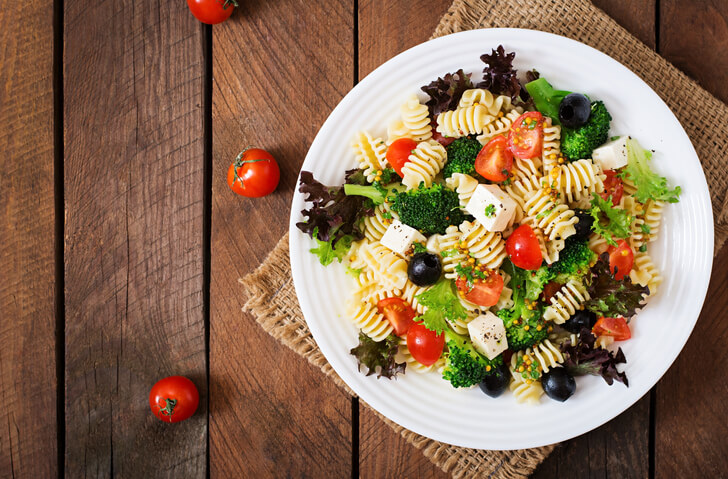Plates Send Disturbing Message About Portion Control. Here’s How To Be Proactive
6 years ago | Nutrition
By Joy Stephenson-Laws, JD, Founder
Recently, a certain brand of dishware served up more than just the latest home cooked meal. And to some, it wasn’t too appetizing. In fact, some considered it downright insulting.
Plates created by a company called Pourtions have circles within circles painted on them. The biggest circle is labeled “mom jeans,” the second to largest is “favorite jeans” and the smallest circle is “skinny jeans.” So basically, the smaller amount you eat the more likely you will be able to fit into those skinny jeans that may be living in the back of your closet because you haven’t been able to lose those couple of extra unwanted pounds.
The president of Pourtions said the plates were “meant to be a lighthearted take on the important issue of portion control,” according to this report. But the message they sent is not just insulting to women and mothers, but it may also be wrong and unhealthy.
For example, if you are serving yourself a nutrient-rich meal of leafy greens, seasonal vegetables and quinoa, you probably want to fill up that big circle on your plate. In my opinion, when it comes to portions, it’s less about how much you eat and more about what you eat.
So it is not surprising that the Pourtions plates received a lot of negative attention. Many suggested that Pourtions promoted eating disorders. (Reportedly, 30 million Americans suffer from an eating disorder).
Celebrities on social media even had a few choice words about the plates.
“F*ck these plates. F*ck these plates to hell,” tweeted Jameela Jamil, actress and body positivity activist.
Writer and television correspondent Alie Ward asked retail powerhouse Macy’s to stop selling these plates at once, and they did!
This may all seem kind of silly, but I think it’s important to have an awareness regarding the false nutrition and dieting messages fed to us ( sometimes literally!) through things we may buy, magazines we may read and commercials we may watch on television.
And whoever came up with the idea for the Pourtions plates, probably didn’t think too much of it or may have even been inspired by studies saying that larger plates will make you eat more. But one has to be cautious when relying on these studies and apply common sense to their interpretation.
Now there is even a study to the contrary which suggests that a smaller plate won’t help you eat less when you are hungry.
With all this said, this does not mean that you should never practice portion control or moderation when it comes to your eating habits.
So how can you be proactive about portion control?
As with most things regarding health and nutrition, there is not a one-size-fits-all approach. And if you have any existing health issues or are pregnant or breastfeeding, your portion requirements may vary.
But here are a few general tips:
- If you are a meat-eater, your meat portion should usually be no larger than the size of a deck of cards or the palm of your hand.
- Keep grains and pastas to a cup or two (may be able to do more if you are not a meat-eater)
- When it comes to non-starchy vegetables, such as leafy greens, broccoli and asparagus, you can pretty much eat as much as you want (within reason).
- Fruit is a great, whole nutrient-dense food, but it contains sugar. Try to measure your fruit in cups, especially when making smoothies (which usually contain multiple types of fruit).
- Nutrient-void, processed foods should definitely be consumed in moderation (if at all).
One tool you can use is Create Your Plate, provided by the American Diabetes Association. This will help manage your blood glucose levels and possibly help you lose weight by telling you what percentage of your plate should be protein, fruit, non-starchy vegetables and grains and starchy foods.
You may also want to consider following the Volumetrics Diet, which emphasizes eating quality foods instead of counting calories. As always, speak with a competent healthcare professional about what is best for you.
And remember, we all need six essential nutrients to stay healthy. These nutrients are water, carbohydrates, proteins, fats, vitamins and minerals. And if we are proactive about making sure we get adequate amounts of these essential nutrients, the more satisfied we will feel and be less likely to overeat or reach for unhealthy foods.
It is also important to periodically check whether you are getting enough of the six essential nutrients. And so many of us suffer from nutritional deficiencies whether it’s due to our genetic makeup or just getting older. The good news is getting routine nutrient tests will identify any nutrient imbalances. And if any deficiencies are discovered, a competent healthcare professional can work with you to make the necessary dietary changes and recommend quality supplements you can take if necessary.
Enjoy your healthy life!
The pH professional health care team includes recognized experts from a variety of healthcare and related disciplines, including physicians, attorneys, nutritionists, nurses and certified fitness instructors. This team also includes the members of the pH Medical Advisory Board, which constantly monitors all pH programs, products and services. To learn more about the pH Medical Advisory Board, click here.







